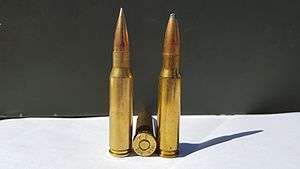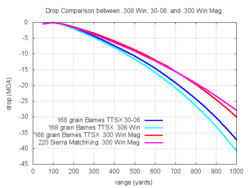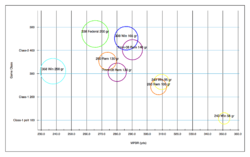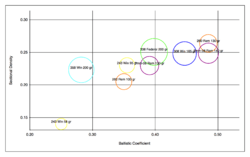.308 Winchester
| .308 Winchester | ||||||||||||||||||||||||
|---|---|---|---|---|---|---|---|---|---|---|---|---|---|---|---|---|---|---|---|---|---|---|---|---|
 .308 Winchester | ||||||||||||||||||||||||
| Type | Rifle | |||||||||||||||||||||||
| Place of origin | United States | |||||||||||||||||||||||
| Production history | ||||||||||||||||||||||||
| Designed | 1952 | |||||||||||||||||||||||
| Specifications | ||||||||||||||||||||||||
| Parent case | .300 Savage [1] | |||||||||||||||||||||||
| Case type | Rimless, Bottleneck | |||||||||||||||||||||||
| Bullet diameter | 0.308 in (7.8 mm) | |||||||||||||||||||||||
| Neck diameter | 0.3433 in (8.72 mm) | |||||||||||||||||||||||
| Shoulder diameter | 0.4539 in (11.53 mm) | |||||||||||||||||||||||
| Base diameter | 0.4709 in (11.96 mm) | |||||||||||||||||||||||
| Rim diameter | 0.4728 in (12.01 mm) | |||||||||||||||||||||||
| Rim thickness | 0.0539 in (1.37 mm) | |||||||||||||||||||||||
| Case length | 2.015 (51.18 mm) | |||||||||||||||||||||||
| Overall length | 2.800 (71.12 mm) | |||||||||||||||||||||||
| Case capacity | 56 gr H2O (3.6 cm3) | |||||||||||||||||||||||
| Primer type | Large rifle | |||||||||||||||||||||||
| Maximum pressure (C.I.P.) | 60,191 psi (415.00 MPa) | |||||||||||||||||||||||
| Maximum pressure (SAAMI) | 62,000 psi (430 MPa) | |||||||||||||||||||||||
| Ballistic performance | ||||||||||||||||||||||||
| ||||||||||||||||||||||||
| Test barrel length: 24 in (26 in for Lapua) [2] | ||||||||||||||||||||||||
The .308 Winchester (pronounced: "three-oh-eight") is a rimless, bottlenecked rifle cartridge and is the commercial cartridge from which the 7.62×51mm NATO round was derived. The .308 Winchester was introduced in 1952, two years prior to the NATO adoption of the 7.62×51mm NATO T65. Winchester branded the cartridge and introduced it to the commercial hunting market as the .308 Winchester. Winchester's Model 70, model 100 and Model 88 rifles were subsequently chambered for the new cartridge. Since then, the .308 Winchester has become the most popular short-action, big-game hunting cartridge worldwide.[3] It is also commonly used for civilian hunting, target shooting, metallic silhouette, bench rest target shooting, palma, metal matches, military sniping, and police sharpshooting. The relatively short case makes the .308 Winchester especially well-adapted for short-action rifles. When loaded with a bullet that expands, tumbles, or fragments in tissue, this cartridge is capable of high terminal performance.[4][5][6]
Although very similar to the military 7.62×51mm NATO specifications, the .308 cartridge is not identical, and there are special considerations that may apply when mixing these cartridges with 7.62×51mm NATO, and .308 Winchester chambered arms.[7] Their interchange is, however, considered safe by the Sporting Arms and Ammunition Manufacturers Institute (SAAMI).[8]
Cartridge dimensions
The .308 Winchester has 3.64 ml (56.0 grains) cartridge case capacity.[9] The exterior shape of the case was designed to promote reliable case feeding and extraction in bolt action rifles and machine guns alike, under extreme conditions.
.308 Winchester maximum C.I.P. cartridge dimensions. All dimensions in millimeters (mm) and inches.
Americans would define the shoulder angle at alpha/2 = 20 degrees. The common rifling twist rate for this cartridge is 305 mm (1 in 12 in), 4 grooves, Ø lands = 7.62 mm, Ø grooves = 7.82 mm, land width = 4.47 mm and the primer type is large rifle.[10]
According to the official C.I.P. (Commission Internationale Permanente pour l'Epreuve des Armes à Feu Portatives) rulings the .308 Winchester can handle up to 415.00 MPa (60,191 psi) Pmax piezo pressure. In C.I.P. regulated countries every rifle cartridge combo has to be proofed at 125% of this maximum C.I.P. pressure to certify for sale to consumers. This means that .308 Winchester chambered arms in C.I.P. regulated countries are currently (2008) proof tested at 519.00 MPa (75,275 psi) PE piezo pressure.[11]
North American SAAMI maximum pressure for the 308 Winchester is 430 MPa (62,000 psi).[12]
Usage and performance
The .308 Winchester is one of the most popular hunting cartridges in the United States, and possibly the world. It has gained popularity in many countries as an exceptional cartridge for game in the medium- to large-sized class.[13] In North America it is used extensively on whitetail deer, pronghorn and even the occasional caribou or black bear.
Clay Harvey, an American gun writer, says it is usable on moose and elk.[14] Layne Simpson, an American who has hunted in Sweden, says he is surprised how many hunters there use the cartridge.[15] Craig Boddington was told by a Norma Precision executive that the .308 Winchester is one of Norma's best-selling calibers.[16]
In Africa the .308 Winchester is one of the most popular calibers among Bushveld hunters and is used on anything from duiker right up to the massive eland (a small and large African antelope respectively). Proponents of the hydrostatic shock theory contend that the .308 Winchester has sufficient energy to impart hydrostatic shock to living targets when rapidly expanding bullets deliver a high rate of energy transfer.[4][6][17][18]
While .308 Winchester has traditionally been the most popular cartridge in the past, the development of lighter recoil chamberings with sufficient downrange energy, like the 7mm-08 Remington, .260 Remington, and 6.5 Creedmoor, is becoming more common for metallic silhouette shooting.[19]
The PALMA shooting is a variant of full bore target shooting done with a bolt action rifle in 7.62mm NATO caliber (.308 Winchester) and fire Match Grade 155 grain bullets using micrometer aperture (iron) sights at out to 1,000 yards.[20]
F-Class is a variant of Fullbore Target Rifle which permits optical telescopic sights and shooting rests in the front and rear like for instance like a bipod and/or bags. Competitions are fired at distances between 300 and 1200 meters (or yards), and the targets are half the size of those used in traditional Palma shooting. Based on equipment, competitors can choose to compete in one of the two classes Open or Standard: F-TR ("Target", Standard Class): A restricted class permitting a scope, bipod/ backpack and rear bag (no front rest), but the rifle has to be of either caliber .223 Remington or .308 Winchester. In addition, the weight limit including optics is 8.25 kg (18.15 lbs).
The .308 Winchester has slightly more drop at long range than the .30-06 Springfield, owing to its slightly lower (around 30 metres per second (100 ft/s)) muzzle velocity with most bullet weights. Cartridges with significantly higher muzzle velocities, such as the .300 Winchester Magnum can have significantly less drop at long range, but much higher recoil.
 Trajectory comparisons between .308 Winchester, .30-06 Springfield, and .300 Winchester Magnum[21]
Trajectory comparisons between .308 Winchester, .30-06 Springfield, and .300 Winchester Magnum[21]- Ultra-high speed photo of a 150 grain FMJ .308 Winchester bullet photographed with an air-gap flash.
- A side-by-side size comparison between the .308 Winchester (left) and its precursor the .300 Savage (right).
As a parent case
Several more cartridges have been developed using the .308 Winchester as a parent case, some becoming very popular for hunting, particularly in North America.[10] These are the .243 Winchester, the .260 Remington (a.k.a. 6.5-08 A-Square), the 7 mm-08 Remington, the .338 Federal, and the .358 Winchester (a.k.a. 8.8×51mm). In 1980, two rimmed cartridges based on the .308 Winchester were introduced for use in the Winchester Model 94 XTR Angle Eject rifle: the .307 Winchester and the .356 Winchester. In 2014, the rimless 45 Raptor was introduced to provide a big bore cartridge for the AR-10 by combining the .308 Winchester with the .460 S&W Magnum.


See also
References
- ↑ The .300 Savage by Chuck Hawks
- ↑ Federal Gold Medal 308 Win. Sierra® MatchKing® Boat-Tail Hollow Point Match Grade 168
- ↑ Simpson, Layne (February 2000). "The 20th Century's Top Rifle Cartridge". Archived from the original on 14 May 2008. Retrieved 2008-06-06.
- 1 2 Chamberlin FT, Gun Shot Wounds, in Handbook for Shooters and Reloaders, Vol. II, Ackley PO, ed., Plaza Publishing, Salt Lake City, Utah, 1966.
- ↑ Courtney A, Courtney M: Links between traumatic brain injury and ballistic pressure waves originating in the thoracic cavity and extremities. Brain Injury 21(7): 657-662, 2007. arXiv:0808.1443
- 1 2 Scientific Evidence for Hydrostatic Shock arXiv:0803.3051
- ↑ 7.62×51mm NATO or 308 Winchester?
- ↑ SAAMI Unsafe Arms and Ammunition Combinations Archived 2013-11-16 at the Wayback Machine.
- ↑ Hornady Handbook of Cartridge Reloading, Fourth Edition, 1991, Hornady Manufacturing Company, Grand Island, NE.
- 1 2 Nosler Reloading Guide Number Four, 1996, Nosler, Inc., Bend OR.
- ↑ C.I.P. TDCC sheet .308 Winchester
- ↑ The Sporting Arms and Ammunition Manufacturing Institute (SAAMI), composed of representatives of the firearms, ammunition and components manufacturers, with the purpose of standardizing specs in North America
- ↑ Speer Reloading Manual Number 12, 1994, Blount, Inc., Lewiston, ID.
- ↑ Popular Sporting Rifle Cartridges DBI Books, 1984.
- ↑ "The 20th Century's Top Rifle Cartridge," Shooting Times, Feb. 2000. Accessed online Dec. 31, 2012. The "top" rifle cartridge in the century, he says, is the .30-06.
- ↑ "Best Sellers," RifleShooter, Jan.Feb. 2013.
- ↑ Sturtevant B, Shock Wave Effects in Biomechanics, Sadhana, 23: 579-596, 1998.
- ↑ Suneson A, Hansson HA, Seeman T: Pressure Wave Injuries to the Nervous System Caused by High Energy Missile Extremity Impact: Part I. Local and Distant Effects on the Peripheral Nervous System. A Light and Electron Microscopic Study on Pigs. The Journal of Trauma. 30(3):281–294; 1990.
- ↑ "Sport Shooting Association of Austrialia". Retrieved 20 March 2017.
- ↑ "Palma USA". Retrieved 31 March 2017.
- ↑ Litz, Brian. Applied Ballistics for Long Range Shooting. Cedar Springs, MI : Applied Ballistics, LLC, 2009.
- C.I.P. decisions, texts and tables (free current C.I.P. CD-ROM version download (ZIP and RAR format))
External links
| Wikimedia Commons has media related to .308 Winchester. |
- Ultra-high speed .308 photos amateur high speed photography
- .308 Winchester Cartridge Guide by AccurateShooter.com
- .308 Videos by StoppingPower.Info
